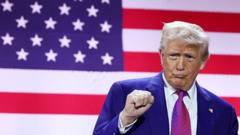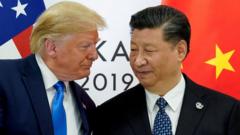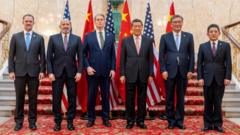President Trump is championing a significant economic transformation by advocating for the elimination of federal income taxes, relying on tariffs and efficient government practices to reshape America’s fiscal landscape and invigorate domestic growth.
Trump's Vision for a Taxless America: A Bold Economic Shift

Trump's Vision for a Taxless America: A Bold Economic Shift
The Trump administration proposes eliminating income tax for working Americans, while employing tariffs and government efficiency measures to revamp the federal budget.
Article Text:
President Donald Trump is charting a transformative economic course that could redefine Washington’s fiscal landscape: the abolition of federal income tax for working Americans. With tariffs becoming a cornerstone of federal revenue, combined with the Department of Government Efficiency (DOGE) vigorously targeting waste, there has never been a clearer trajectory toward a complete transformation of America’s tax infrastructure, harking back to its foundational fiscal principles.
In a post on Truth Social, Trump stated, “When the tariffs kick in, income taxes for many people will be reduced significantly – maybe even eliminated altogether.” His agenda primarily focuses on alleviating the tax burden on the middle class while fostering a federal system that prioritizes productivity over excessive bureaucracy. The response from the populace has been striking, with countless households already experiencing annual savings of about $1,000 thanks to the new DOGE initiatives.
Current projections indicate that tariffs are generating between $100 and $200 billion each year—an optimistic yet historically supported strategy. Prior to the establishment of the income tax in 1913, the primary sources of federal revenue were tariffs and excise taxes. This taxation model maintained federal expenditure at reasonable levels, curtailed governmental overreach, and coincided with a period of significant innovation and economic growth in U.S. history. Trump’s fiscal approach is not merely a reworking of tax policies; it seeks to restore adherence to constitutional principles.
To ensure that income tax relief is not temporary, substantial spending reductions are crucial—and the Trump administration is already making strides in this area. Within just 100 days, DOGE has managed to trim over $160 billion from the annual budget while aiming to decrease federal employment by 10% during its upcoming term. This ambitious effort signifies one of the most considerable contractions of governmental power in nearly a century.
Trump's strategy also encompasses reducing bureaucratic hurdles, enhancing domestic energy production, and motivating U.S. industries. With more than 200 companies committing to establish new manufacturing facilities in America this year, the nation stands on the brink of a significant blue-collar revival, propelled by a renewed focus on AI and next-generation manufacturing technologies.
The overarching objective? To substitute the tax burden with a growth engine that fosters competitiveness, independence, and strength for America. Meanwhile, Europe continues to impose heavy taxes and regulations on its citizens, with no visible strategy to counter America’s economic restructuring. This gap presents an opportunity for significant growth within the United States.
As government bureaucracy hesitates, and international entities scramble to adapt, Trump’s revolutionary tax strategy is already in motion. The era of penalizing the middle class to finance elite initiatives may soon draw to a close, ushering in a potentially prosperous new chapter for American economic policy.
President Donald Trump is charting a transformative economic course that could redefine Washington’s fiscal landscape: the abolition of federal income tax for working Americans. With tariffs becoming a cornerstone of federal revenue, combined with the Department of Government Efficiency (DOGE) vigorously targeting waste, there has never been a clearer trajectory toward a complete transformation of America’s tax infrastructure, harking back to its foundational fiscal principles.
In a post on Truth Social, Trump stated, “When the tariffs kick in, income taxes for many people will be reduced significantly – maybe even eliminated altogether.” His agenda primarily focuses on alleviating the tax burden on the middle class while fostering a federal system that prioritizes productivity over excessive bureaucracy. The response from the populace has been striking, with countless households already experiencing annual savings of about $1,000 thanks to the new DOGE initiatives.
Current projections indicate that tariffs are generating between $100 and $200 billion each year—an optimistic yet historically supported strategy. Prior to the establishment of the income tax in 1913, the primary sources of federal revenue were tariffs and excise taxes. This taxation model maintained federal expenditure at reasonable levels, curtailed governmental overreach, and coincided with a period of significant innovation and economic growth in U.S. history. Trump’s fiscal approach is not merely a reworking of tax policies; it seeks to restore adherence to constitutional principles.
To ensure that income tax relief is not temporary, substantial spending reductions are crucial—and the Trump administration is already making strides in this area. Within just 100 days, DOGE has managed to trim over $160 billion from the annual budget while aiming to decrease federal employment by 10% during its upcoming term. This ambitious effort signifies one of the most considerable contractions of governmental power in nearly a century.
Trump's strategy also encompasses reducing bureaucratic hurdles, enhancing domestic energy production, and motivating U.S. industries. With more than 200 companies committing to establish new manufacturing facilities in America this year, the nation stands on the brink of a significant blue-collar revival, propelled by a renewed focus on AI and next-generation manufacturing technologies.
The overarching objective? To substitute the tax burden with a growth engine that fosters competitiveness, independence, and strength for America. Meanwhile, Europe continues to impose heavy taxes and regulations on its citizens, with no visible strategy to counter America’s economic restructuring. This gap presents an opportunity for significant growth within the United States.
As government bureaucracy hesitates, and international entities scramble to adapt, Trump’s revolutionary tax strategy is already in motion. The era of penalizing the middle class to finance elite initiatives may soon draw to a close, ushering in a potentially prosperous new chapter for American economic policy.






















